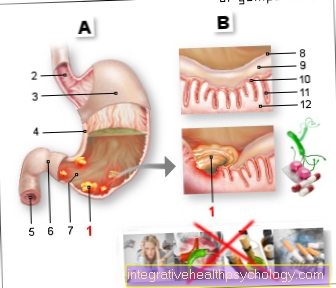Effect of radiation therapy
Synonyms
- Radiation oncology
- Irradiation
- Tumor irradiation
effect

High-energy photon and particle radiation are among the ionizing rays. If such radiation hits matter, e.g. Water, energy from the radiation is transferred to the atoms or molecules of the water and leads to ionization there. The charged particles that are created are themselves very reactive and can change neighboring molecules.
The types of radiation differ greatly in the type of energy transfer and can be used more or less therapeutically thanks to these properties.
The most commonly used rays in the therapeutic field are high-energy X-rays and electron beams. After entering the tissue, the energy output in the tissue for the high-energy X-ray radiation increases to a certain depth and then slowly decreases. In electron radiation, the area of maximum energy transfer is very close to the surface and drops rapidly in depth. Electron beams are therefore more suitable for treating processes near the surface and high-energy X-rays for deeper ones.
The aim of radiation therapy in humans is to damage the existing tumor cells through the transfer of energy in such a way that they subsequently perish. The resulting reactive water molecules lead to changes or damage to the DNA of the cell. The information for controlling the metabolic processes of the cell is contained in the DNA. If critical damage occurs in this molecule, the tumor cell can no longer control its vital processes and can no longer divide. Ultimately, this leads to the death of the tumor cell and, ideally, the entire tumor.
The aim of every radiation therapy must therefore be to shift the highest energy transfer of the radiation into the area of the tumor. To achieve this, modern computer-controlled treatment devices are used today. These help to get a very precise prediction of the dose distribution in the body.
Would you like to know what long-term effects can occur after irradiation?
- Find out about the Long-term effects after radiation treatment.




























.jpg)
.jpg)